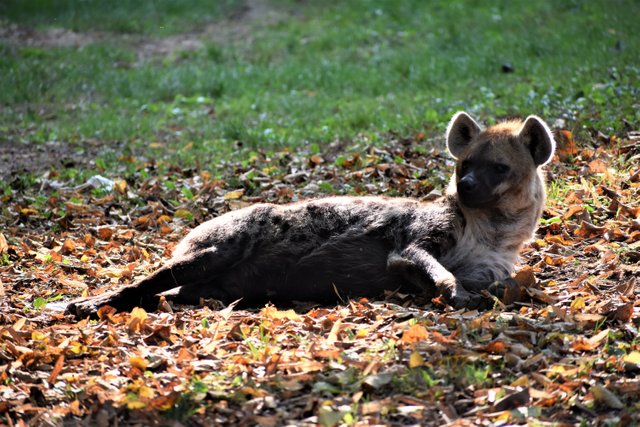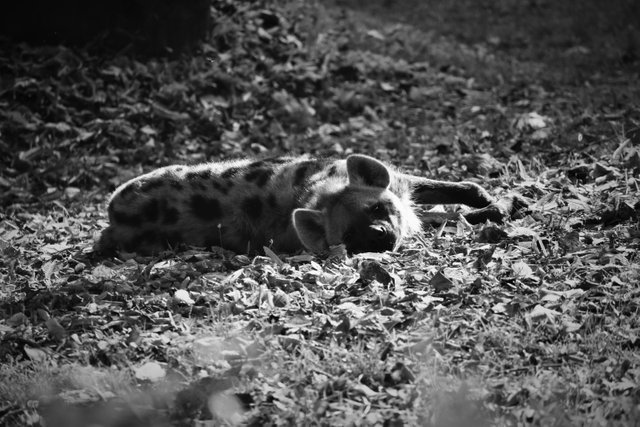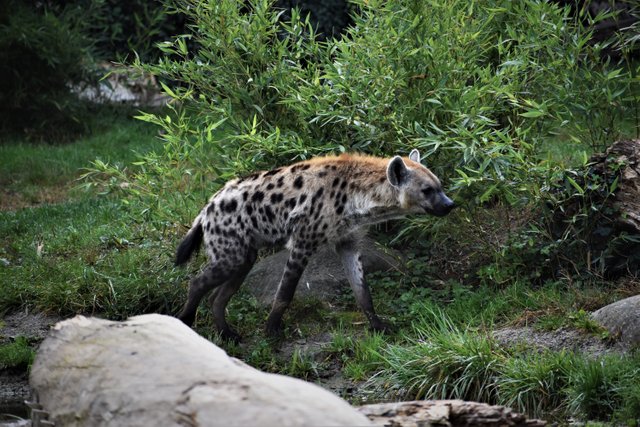 |  |
|---|
The spotted hyena (Crocuta crocuta, Erxleben, 1777) is a large carnivorous mammal originating in sub-Saharan Africa. Females reach an average weight of 55 kilograms while males, smaller, only 45; in particularly open areas specimens able to reach 70 kilograms have been observed. The average length of the body is just under a meter and a half and the height at the shoulder is around 75 centimeters. The fur can take on different shades ranging from sand-colored to brick-red, but all are characterized by the presence of dark spots. Unlike other hyenas, the spotted hyena is easily identifiable due to round ears and a particularly massive neck which give it a certain resemblance to bears.
It is an animal extensively studied from the ethological and genetic point of view. This has helped, over the years, to create different debates about its phylogenetic classification. The analyzes carried out on the fossil record, in fact, confirmed that the ancestors of the spotted hyena, during the Pleistocene, had colonized a large part of the Eurasian continent, regressing towards the countries of origin only at a later time. This expansion with subsequent reorganization of the area has led many researchers to suggest the presence, today, of different subspecies, in particular C. c. crocuta for western populations, C. c. capensis for the southern ones and C. c. habessynica for the eastern ones; in reality, both from the morphological and ethological point of view, but above all from the reproductive one, there are no differences between these three subspecies, and the division is considered artificial by many and of no use.
La iena maculata (Crocuta crocuta, Erxleben, 1777) è un grosso mammifero carnivoro originario dell’Africa Subsahariana. Le femmine raggiungono mediamente il peso di 55 chilogrammi mentre i maschi, più piccoli, solo 45; in zona particolarmente aperte sono stati osservati esemplari in grado di raggiungere i 70 chilogrammi. La lunghezza media del corpo è di poco inferiore al metro e mezzo e l’altezza alla spalla si aggira attorno ai 75 centimetri. La pelliccia può assumere diverse sfumature che vanno dal color sabbia al rosso mattone, ma tutte si caratterizzano per la presenza di evidenti macchie scure. A differenza di altre iene, la iena maculata è ben identificabile per orecchie rotonde e il collo particolarmente massiccio che le conferiscono una certa somiglianza con gli orsi.
Si tratta di un animale estesamente studiate dal punto di vista etologico e genetico. Questo ha contribuito, nel corso degli anni, a creare diversi dibattiti circa la sua classificazione filogenetica. Le analisi eseguite sui reperti fossili, infatti, hanno confermato che gli antenati della iena maculata, durante il Pleistocene, avevano colonizzata buona parte del continente euroasiatico, regredendo verso i paesi di origine solo in un secondo momento. Questa espansione con successivo ridimensionamento dell’areale ha indotto molti ricercatori a suggerire la presenza, al giorno d’oggi, di sottospecie differenti, in particolare C. c. crocuta per le popolazioni occidentali, C. c. capensis per quelle meridionali e C. c. habessynica per quelle orientali; in realtà, sia dal punto di vista morfologico che da quello etologico, ma soprattutto da quello riproduttivo, non esistono differenze tra queste tre sottospecie, e la divisione viene considerata da molti artificiosa e di nessuna utilità.

ORIGINAL WORK BY SPAGHETTISCIENCE
If you need this or other images, just ask!
It didn't take long to convince me that hyenas are second only to chimpanzees in terms of charm, because they are born clowns, absolutely individualistic and live in a well-ordered and extremely complex society. Jane Goodall.
Despite the poor sympathy that hyenas generally arouse in those who observe them, from an ethological point of view they are extremely interesting animals. The social organization is the most complex of carnivores, and is generally among the most orderly in the animal world. The society is matriarchal, and the females cover all the most important roles of the pack, which takes the name of clan; even the females who hold the lowest hierarchical roles are considered more "important" than the males with the highest roles. Clans play an important role in aggregating and defending the territory, while daily activities such as hunting are normally carried out in smaller groups, often with relatives. In this aspect, the organization of hyenas seems very similar to the first social organizations of human kind, in which the union in large tribes did not prejudice the formation of more contained groups. The dynamics that regulate hierarchies in no way foresee the presence of violent acts, but the dominances are established through the interweaving of social relations and alliances, which result in the choice of a "leader" to follow.
Like most felines, hyenas are extremely promiscuous from a sexual point of view and there are no fixed pairs. Mating occurs throughout the whole year and pregnancies last about four months. At the end of the gestation, well-formed puppies are born, which immediately implement typical adult behaviors; the puppies' games itself are able to establish the first hierarchies. The puppies are raised in a common shelter that can reach up to ten puppies; while education is imparted in a common way, each female tends, however, to feed only her own, distancing others.
Unlike what is thought, hyenas do not feed only on carcasses taken from other predators (which however do not disdain during daytime hours), but are also extremely efficient nocturnal predators. They are able to chase their prey for miles, then reach them for exhaustion.
Non ci volle molto per convincermi che le iene sono seconde solo agli scimpanzé quanto a fascino, perché sono dei pagliacci nati, assolutamente individualiste e vivono in una società ben ordinata ed estremamente complessa. Jane Goodall.
A dispetto della scarsa simpatica che generalmente le iene suscitano in chi le osserva, dal punto di vista etologico esse risultano essere animali estremamente interessanti. L’organizzazione sociale e la più complessa tra i carnivori, e risulta in generale tra le più ordinate del mondo animale. La società è matriarcale, e le femmine ricoprono tutti i ruoli più importanti del branco, che prende il nome di clan; persino le femmine che ricoprono i ruoli gerarchici più bassi vengono considerate più “importanti” dei maschi con i ruoli più alti. I clan rivestono un importante ruolo di aggregazione e di difesa del territorio, mentre le attività quotidiane come la caccia vengono normalmente svolte in gruppi più piccoli, spesso familiari. Sotto questo aspetto, l’organizzazione delle iene sembra molto simile alle prime organizzazioni sociali dell’uomo stesso, in cui l’unione in grandi tribù non pregiudicava comunque la formazione di gruppi più contenuti. Le dinamiche che regolano le gerarchie non prevedono in alcun modo la presenza di atti violenti, ma le dominanze vengono stabilite attraverso l’intreccio di relazioni sociali e alleanze, che sfociano nella scelta di un “capo” da seguire.
Come la maggior parte dei felini, dal punto di vista sessuale le iene sono estremamente promiscue e non esistono coppie fisse. Gli accoppiamenti avvengono durante tutto l’anno e le gravidanze durano circa quattro mesi. Al termine della gestazione nascono cuccioli già ben formati, che mettono in atto fin da subito comportamenti tipici degli adulti; il gioco stesso dei cuccioli è in grado di stabilire le prime gerarchie. I cuccioli vengono allevati in un rifugio comune che può arrivare a contenere decina di cuccioli; mentre l’educazione viene impartita in modo comune, ciascuna femmina tende però ad allattare solo i proprio piccoli, allontanando gli altri.
Diversamente da quanto si pensa, le iene non si cibano unicamente di carcasse sottratte ad altri predatori (che comunque non disdegnano durante le ore diurno), ma sono anche predatori notturni estremamente efficienti. Sono in grado di inseguire per chilometri le proprie prede, raggiungendole poi per sfinimento.

ORIGINAL WORK BY SPAGHETTISCIENCE
If you need this or other images, just ask!
From a food standpoint, the most direct competitor of hyenas is certainly the lion; the behaviors put in place from time to time are however far from discounted and predictable, and vary considerably based on various factors. In situations of abundance of food, hyenas and lions were repeatedly observed together during meals, sometimes sharing the same prey. In more complicated scenarios, lions tend to implement aggressive behaviors towards hyenas, moving them away from carcasses until their meal is completed; in the same way, however, very numerous hyene clans are able to remove lions, especially in the absence of adult males. However, the lion remains one of the main causes of mortality for hyenas, which respond to this pressure by trying to keep the lions out of their territories.
Food clashes are not infrequent even with other animals such as the cheetah, which usually prefers to go away, and the leopard, which instead shows aggressive attitudes.
Dal punto di vista alimentare, il più diretto concorrente delle iene è sicuramente il leone; i comportamenti messi in atto di volta in volta sono però tutt’altro che scontati e prevedibili, e variano notevolmente in base a diversi fattori. In situazioni di abbondanza di cibo, iene e leoni sono stati più volte osservati insieme durante i pasti, talvolta condividendo le stesse prede. In scenari più complicati, i leoni tendono a mettere in atto comportamenti aggressivi nei confronti delle iene, allontanandole dalle carcasse fino al completamento del proprio pasto; allo stesso modo, però, clan molto numerosi di iene sono in grado di allontanare leoni, soprattutto in assenza di maschi adulti. Il leone resta comunque una delle principali cause di mortalità per le iene, che rispondono a questa pressione cercando di tenere i leoni fuori dai propri territori.
Non sono infrequenti scontri per il cibo anche con altri animali come il ghepardo, che solitamente preferisce allontanarsi, e il leopardo, che invece mostra atteggiamenti aggressivi.

ORIGINAL WORK BY SPAGHETTISCIENCE
If you need this or other images, just ask!
Curiosity
Females have an extremely pronounced pseudo-penis, which makes it extremely difficult to discriminate between males and females to the untrained eye. The pseudo-penis is formed by an overdeveloped clitoris, which comes to resemble in an impressive way to a real penis. It performs various functions, including reproductive and excretory, while the vagina is fused and not open to the outside. It is not clear which evolutionary thrust led to the formation of a similar structure, but it is thought that it is due to the social organization of hyenas. Being a matriarchal society, female puppies represent a potential danger to the dominant female, which tends to kill them. The presence of a pseudo-penis so pronounced can be considered a form of mimicry, which makes it difficult to identify a male from a distance from a female, limiting the aggressive behavior of the dominant.
Curiosità
Le femmine sono dotate di uno pseudo-pene estremamente pronunciato, che rende estremamente difficile la discriminazione tra maschi e femmine ad un occhio inesperto. Lo pseudo-pene è formato da una clitoride sovrasviluppata, che arriva ad assomigliare in modo impressionante ad un vero e proprio pene. Esso svolge diverse funzioni, tra cui quella riproduttiva ed escretrice, mentre la vagina è fusa e non aperta verso l’esterno. Non è chiaro quale spinta evolutiva abbia portato alla formazione di una struttura simile, ma si pensa che essa sia dovuta proprio all’organizzazione sociale delle iene. Trattandosi di una società matriarcale, i cuccioli di sesso femminile rappresentano un potenziale pericolo per la femmina dominante, che tende ad ucciderle. La presenza di uno pseudo-pene così pronunciato può essere considerata una forma di mimetismo, che rende difficilmente identificabile da lontano un maschio da una femmina, limitando i comportamenti aggressivi della dominante.
IUCN Red List

LC = Least concern. Source.
References
- Animaldiversity. Crocuta crocuta.
- IUCN Red List.
- Kay E. Holekamp (2007). Social intelligence in the spotted hyena (Crocuta crocuta).

This post was selected, voted and shared by the discovery-it curation team in collaboration with the C-Squared Curation Collective. You can use the #Discovery-it tag to make your posts easy to find in the eyes of the curator. We also encourage you to vote @c-squared as a witness to support this project.
Downvoting a post can decrease pending rewards and make it less visible. Common reasons:
Submit
This post has been voted on by the SteemSTEM curation team and voting trail. It is elligible for support from @curie.
If you appreciate the work we are doing, then consider supporting our witness stem.witness. Additional witness support to the curie witness would be appreciated as well.
For additional information please join us on the SteemSTEM discord and to get to know the rest of the community!
Please consider setting @steemstem as a beneficiary to your post to get a stronger support.
Please consider using the steemstem.io app to get a stronger support.
Downvoting a post can decrease pending rewards and make it less visible. Common reasons:
Submit
Molto interessante!
Downvoting a post can decrease pending rewards and make it less visible. Common reasons:
Submit